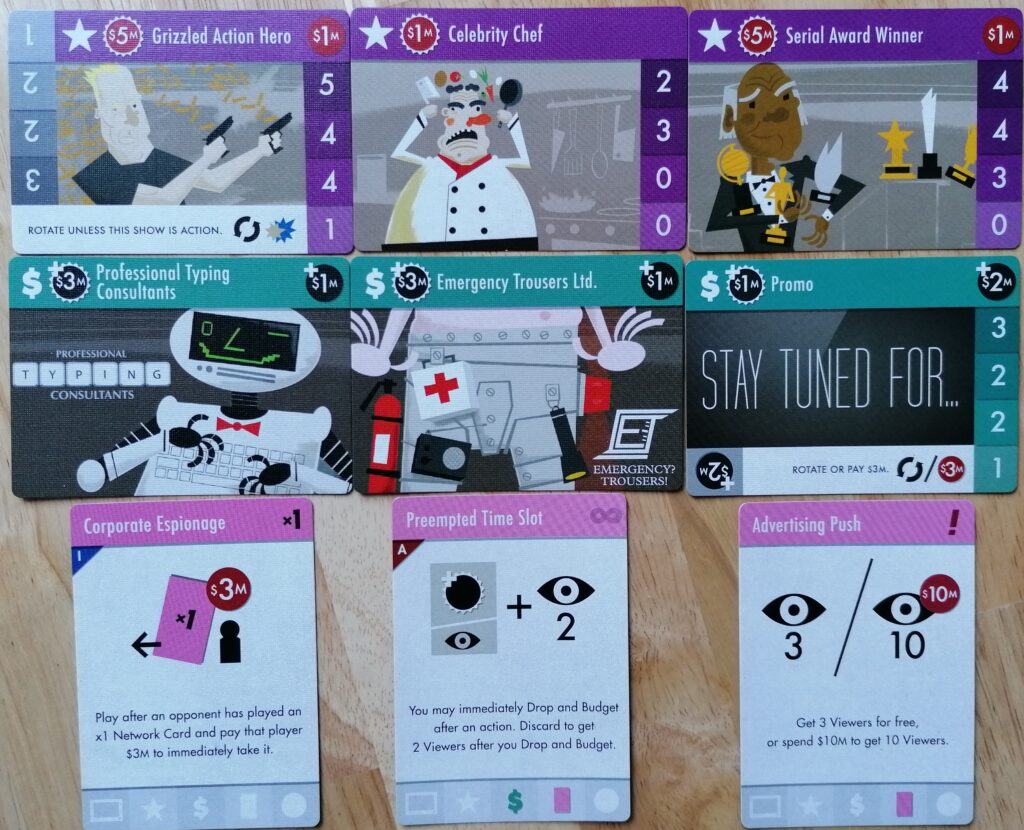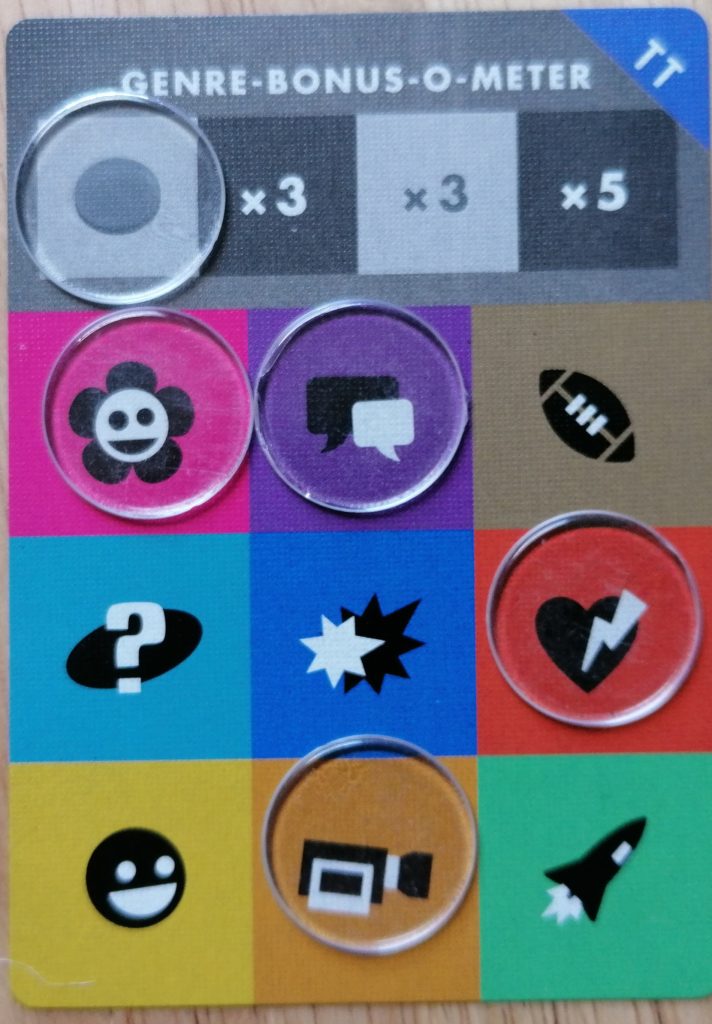When I first saw The Networks, I was drawn in by the artwork. One glance at the cover and I don’t see how anyone wouldn’t be. Even if the style isn’t something you like, it’s certainly intriguing. It’s very cartoony, with an overexaggerated look to each piece, immediately giving you a taste of what kind of game this will be. It’s one that contains humour, parodying reality. From the box art, you can make out at least one or two imitations of well-known TV personalities. And I enjoy that.

In The Networks, you run a TV station, trying to gain the most viewers over five seasons (rounds). You’ll achieve this by airing the most popular shows, attracting the best stars for you shows, and attaching the best adverts to them. Of course, you’ll need to be able to recognise when the shows start to lose popularity, or when your star is becoming old news. To begin the game, each player will be given three starting shows, one in each timeslot (8pm, 9pm and 10pm), a starting star, and a starting advert, which both begin in the green room, ready to be attached to a show. Your starting shows won’t get you any views as they are (after all, who’s going to visit a new TV station which has ‘Know That Rash!’ as its headline show), so you’ll want to develop at least one new TV show as quickly as possible, and stick them into the reruns for a season (after which they move to the archives), where miraculously, they will gain you one view (indicated by the number next to the eye in the bottom left of the card).

Each show beyond your starting ones have a few different parts to them, and you’ll need to pay attention to all of them. In the top left is the type of show it is i.e. action, sports etc., and if you ever acquire a third or fifth of one genre (you also count all shows in the reruns and archives) , you’ll gain a bonus. Here you’ll gain a free card, potentially some money, and, in the case of acquiring a fifth of one genre, allow you to trade money for more views. It’s a nice addition, and in some ways, thematic, as it rewards you for specialising. It isn’t something that’s easy to do, however, as all other players will be picking from a limited amount of shows each season, meaning they could easily snatch up something you may be aiming for, so it might not be worth focusing on too much.
Most, if not all, shows in The Networks, will have an initial cost to develop (shown next to the genre in a red circle), but some will also have an ongoing cost (the red circle in the top right). Next to the number indicating how many views the show will get you in the reruns, there are some symbols, sometimes coloured and sometimes not. If coloured, this means that they require a star or advert in order to be developed, and if grey, it means that you can add one or both of these at a later time, but they do not require them. The title of the show and the pictures are amusing; when one is played it will spark a discussion between the players about what they are parodying (some are easier than others). My favourite parts of the shows though are the preferred timeslot, which is shown just beneath the genre, and the views shown on the right-hand side. Upon developing a show, you can choose to put it in any timeslot you want, but if they are in their preferred timeslot, you will get the most views from them in the first season of them being in your line-up. This leads to the views themselves, but I can also see this part being somewhat confusing for some. The seasons of a show are different to the seasons of the game in The Networks, meaning that you can be in the third season of the game, but still be on the first or second season of a show, based on when you developed it. You can also be on various different seasons of various different shows in your line-up. As you get into the game, it ceases to be an issue, and it makes sense thematically, but at first it’s not the easiest thing to get your head around.

The other cards from which you can select in each season of The Networks are new stars, new adverts and network cards. Stars add views to your shows, and work in the same way in that the views increase/decrease based on what season of the show you’re in, as well as the fact that they’ll have an upfront cost and a potential ongoing cost. Some also have a preference of genre, and if they’re attached to a different genre of show they prefer, they’ll flip over and add fewer views each season, not just in the first. Adverts will gain you money, both upfront (indicated by the circle in the top-left) and on an ongoing basis (top-right). Occasionally, a promo will even show up, which is yet another thing which will adds views, though you’ll have to pay for it. All put together, trying to match timeslots, genres and costs/income makes for a very enjoyable puzzle for me, and though it’s sounds a bit complicated, in practice it flows well.
Network cards are different to any other. These will give you a bonus, and can be one-time effects to be played whenever you’d like, immediate effects, end-of-game effects or ongoing effects. There are a wide range of these, that can provide you with very different bonuses. Having these cards as part of the game doesn’t really add any complexity, but they do add another dimension to it. They give you something to aim for outside of the others, which all synchronise with each other, and the powers can be very powerful. Also, as there’s no limit to how many you can take, they’re always a viable option, and if you find that you can’t afford to take that new star, or don’t have the prerequisite to develop that new show, taking them could definitely help you.

Looking at the production, The Networks comes off quite well in my opinion. The money, rather than coins, are individual tokens, representing stacks of bills. It’s a small thing as well, but I like that they made the art on these tokens with a slight 3D effect. Though you only get fairly small black cubes to mark the season your shows are in, your player tokens to mark turn order and your total views (points) are brightly coloured and very usable. And usability is where this game shines in terms of production. Your individual player boards list every action you can do, what order you do things at the end of a season, what genre bonuses you can get, and what happens at the end of the game. It also contains a scoring track, so you can easily track the amount of views you’re getting in a season, meaning you can just quickly glance at that when scoring, as opposed to having to add it all up, potentially holding up play. The best part though is the main boards. You get a different board for each player count, and each board shows you exactly which cards, and how many of them, you put out. This makes things so much easier, as you won’t have to refer back to the rulebook to check, or even check it in the first place, as all the information is right there for you. A lot of games obviously don’t need this kind of thing, but I wish that games that do use multiple decks of cards follow the example set by The Networks.

Though The Networks has multiple expansions, I only own, and have only played, one of them, but it’s one that I enjoy. It’s called ‘Telly Time’, and it gives you a new TV show deck, replacing the one in the main game, this time parodying all British TV shows. Though I got most of the references in the base game, it’s nice to have something like this, as it’s closer to home. Telly Time also introduces a few new genres of TV shows: chat shows, children’s shows and quiz shows. When developed, chat shows allow to flip a card which you may have been forced to flip over earlier in the game, for example if you’d placed a star on a genre they didn’t want, and quiz shows allow you to pay for a few extra viewers. Though these additional abilities aren’t mandatory, it’s another option that it gives you, again without adding complexity.

My favourite part to this expansion though is that it changes how you get genre bonuses. I mentioned before that, in the base game, you needed to get multiples of the same genre, and that because you were picking from a limited, shared pool each season, it could prove to be very difficult. In Telly Time, you are given a grid with all nine genres present. Each time you take a new genre (including your starting shows), you will place a clear disc over the relevant symbol, and when you complete a line in any direction, you take the associated bonus, remove the discs from the genres in the line you just completed, and move the disc along the top of the grid once to the right. This disc at the top indicates which type of bonus you take; on the first three occasions you will take the three-genre bonus, and on the fourth you will take the five-genre bonus. I think that, because the bonuses are not massively powerful, it is a good change that they made it a little easier to achieve. It’s a shame that, because the grid includes the newly added genres, you can’t use this system with the base game. Maybe there is a way, but it would probably require you to make a new grid.

The Networks is a very enjoyable game for me. I love the theme of it, and think it is implemented very well. Choosing from the shared card pool feels interactive and tight, without being restrictive. The ability to try to stretch out your turn, or to just pass early for more money or, in later seasons, views, is an interesting choice, and this mechanism is something I enjoy in many other games. I can understand some people maybe not enjoying the humour of it, but it only adds to the experience for me. I can’t see this one leaving my collection anytime soon.

